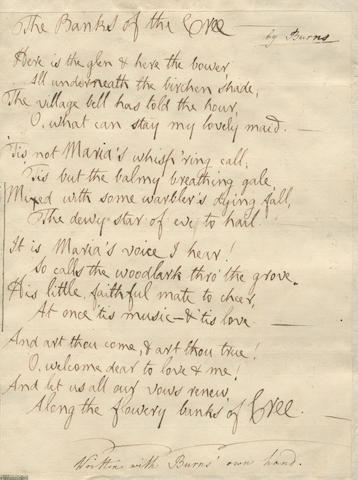A Manuscript titled ‘The Banks of the Cree’ written by Robert Burns sold today at Bonhams Auctions for over £27,000. Also known as ‘Here is the Glen’, these romantic verses were written by Burns to a tune composed by Lady Elizabeth Heron (1745-1811), daughter of the 8th Earl of Dundonald and married to Patrick Heron of Heron (1736-1803) through whose estate, Kerroughtree near Galloway, ran the River Cree.
Heron was an MP for Kircudbright in the decade before his death and Robert Burns, ever interested in local politics, wrote several satirical ballads to aid his election campaign in 1795, including Inscription for an Altar of Independence at Kerroughtree, the seat of Mr Heron. Burns visited Kerroughtree often, and family legend has it that he would often sit at the foot of the main stairs and recite his poetry. Here he has immortalised his friend Lady Elizabeth as the enchanting Maria.
The verses were originally sent by Burns in a letter to his publisher, George Thomson on 7 May 1794, now in the Morgan Library (Dalhousie Manuscripts, MA.50.1), in which Burns noted, ‘…Now, and for six or seven months, I shall be quite in song, as you shall see by-and-by… I got an air, pretty enough, composed by Lady Elizabeth Heron, of Heron, which she calls “The Banks of Cree.” – Cree is a beautiful romantic stream, and, as her ladyship is a particular friend of mine, I have written the following song to it:— Banks of Cree/ Here is the glen, and here the bower…’ ending with the note ‘…The air I fear is not worth your while, else I would send it you…’, which seems to infer that he was not overly impressed with Lady Elizabeth’s composition. However, the literature surrounding these verses agrees that it was Thomson himself and not Burns who disapproved of Elizabeth Heron’s setting and was allegedly ‘always wanting to set Burns’s words to tunes other than those they were written for…’ and that Burns insisted they be ‘printed to the air for which they were written, or else leave them out’ (Burns Chronicle and Club Directory, second series, volume IV, 1929). They were printed in the second volume of Thomson’s Original Scottish Airs in 1798 and have been included in many collections of Burns’ works.
As with so many original Burns manuscripts, as opposed to those produced by the likes of ‘Antique’ Smith, our fair copy of the verses is unsigned but is finished by a characteristic calligraphic flourish. It has one or two small differences in wording compared with the version in his original letter to Thomson, for example the title “The Banks of the Cree” used here rather than “Banks of Cree” and the use of “thro’ the grove” in our copy rather than “in the grove” in Burns’ letter.
Provenance: These verses were rediscovered in an album originating from Denston Hall in Suffolk, the seat of Sir John Robinson (c.1757-1819), who married Rebecca Clive, daughter of Clive of India in 1782. Whether this version was written out for Elizabeth Heron herself is not known, neither is it clear how it came into the possession of John Robinson, but it was evidently added to the album only a few years after publication. Surrounding it, and on the reverse of the leaf, are a selection of newspaper cuttings which can give an approximate terminus ante quem for when our piece was pasted into the album – for example, the verses ‘The Flight of King Joe’ published in the Morning Post on 2 September 1808, and an account of the poisoning by champignons of a Mitcham woman, Mary Attwood, and her children reported in the Gentleman’s Magazine and Historical Chronicle the following month. A skit on Bonaparte, and handwritten anti-French sentiments on the reverse all date it firmly to the first years of the nineteenth century.
Full report can be found HERE






